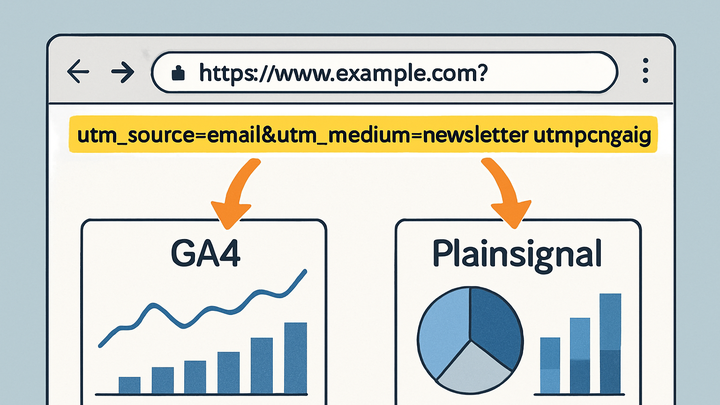Published on 2025-06-26T05:16:21Z
What are URL Parameters? Examples and Best Practices
URL parameters, also known as query string parameters, are key-value pairs appended to the end of a URL
after the question mark (?). They carry additional information that can be read by web
servers, applications, or analytics platforms. In analytics, URL parameters are crucial for attributing
traffic sources, measuring the effectiveness of campaigns, and enabling dynamic content personalization.
By parsing parameters like utm_source, utm_medium, or custom keys, tools such as
Google Analytics 4 and PlainSignal can segment user data and generate detailed reports. Beyond marketing,
developers use URL parameters for filtering results, toggling features, and passing session-specific data.
Url parameters
Key-value pairs appended to URLs for tracking, campaign attribution, and passing data to analytics tools like GA4 and PlainSignal.
Overview of URL Parameters
URL parameters are the part of a web address that comes after a question mark (?). These
parameters consist of key-value pairs that provide additional data to web pages, servers, and analytics
platforms.
They enable marketers and developers to track user behavior, attribute traffic sources, and customize content. In analytics, URL parameters are essential for campaign tracking, A/B testing, and dynamic content delivery.
-
Definition
A URL parameter is a data point in the form
key=valueappended to the end of a URL to transmit information. -
Use cases
URL parameters power various use cases including:
- Campaign attribution and tracking
- A/B testing and feature flags
- Content personalization based on user segments
-
Basic structure
The basic structure of URL parameters consists of a query string and key-value pairs.
-
Query string separator
The question mark (
?) marks the beginning of URL parameters. -
Key-value pair format
Each parameter follows the
key=valueformat, with multiple pairs joined by an ampersand (&).
-
Using URL Parameters in Analytics
Analytical tools rely on URL parameters to classify and attribute website traffic. Standard parameters, such as UTM tags, enable automatic campaign reports in platforms like GA4. Custom parameters allow the capture of additional context, feeding into dashboards for deeper insights.
-
Campaign tracking (utm parameters)
UTM parameters are standardized tags (
utm_source,utm_medium,utm_campaign, etc.) recognized by GA4 and many other analytics platforms for tracking marketing campaigns.-
Example url
https://example.com/landing-page?utm_source=newsletter&utm_medium=email&utm_campaign=summer_sale
-
-
Custom parameters
Custom parameters let you collect additional data beyond UTM tags, such as user IDs, session IDs, or feature flags. These parameters can be read by PlainSignal or forwarded to GA4 as custom dimensions.
Implementation Examples
Example implementations showcase how to integrate URL parameter capture with different analytics solutions.
-
PlainSignal code snippet
Insert PlainSignal’s cookie-free analytics script into your HTML to automatically collect URL parameters and send them as event properties.
-
Tracking script
<link rel='preconnect' href='//eu.plainsignal.com/' crossorigin /> <script defer data-do='yourwebsitedomain.com' data-id='0GQV1xmtzQQ' data-api='//eu.plainsignal.com' src='//cdn.plainsignal.com/plainsignal-min.js'></script> -
How it works
PlainSignal parses
window.location.searchto extract URL parameters and transmits them server-side without relying on cookies.
-
-
GA4 example configuration
Use the gtag.js library to read URL parameters via JavaScript and pass them to GA4 as configuration or event parameters.
-
Code example
<script async src='https://www.googletagmanager.com/gtag/js?id=G-XXXXXXX'></script> <script> window.dataLayer = window.dataLayer || []; function gtag(){dataLayer.push(arguments);} gtag('js', new Date()); const urlParams = new URLSearchParams(window.location.search); gtag('config', 'G-XXXXXXX', { 'campaign_source': urlParams.get('utm_source'), 'campaign_medium': urlParams.get('utm_medium') }); </script> -
Notes
Ensure that the custom parameter keys match the custom dimensions configured in your GA4 property.
-
Best Practices and Common Pitfalls
Maintaining clean and secure URL parameters is vital for reliable tracking and user privacy.
-
Naming conventions
Use clear, lowercase, and consistent parameter names to avoid duplication and confusion.
-
Proper encoding
Apply URL encoding (percent-encoding) to parameter values to handle spaces and special characters correctly. For example, a space becomes
%20. -
Avoid sensitive data
Never pass personally identifiable information (PII) or confidential data in URL parameters, as URLs may be logged or exposed in referrers.
